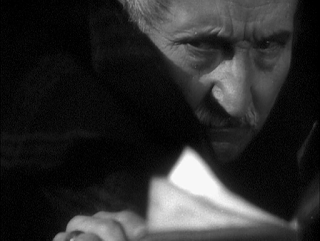“It is there, that she lives…”
There is a house and it’s got Ushers in it but any
resemblance between this film and Edgar Allen Poe’s story is purely surreal. Jean
Epstein’s take on the story reflects the writer’s style, his “totality” in
which every aspect of the tale has a bearing on the core narrative but it was, apparently, too much for co-scripter/assistant
director Luis Buñuel who walked out over this divergence from the original story.
Probably the two fell out over the ending, but no spoilers...
Usher is an outstandingly creepy film - pathetic fallacy running
wild in terms of the relationship between the story and simply everything: architecture,
weather, landscape, clothing, candles and oils… It’s claustrophobic and there’s
no respite from any part of the film as the audience joins the un-named visitor
- Charles Lamy – on his mission to help his friend Roderick Usher (Jean
Debucourt).
 |
| Charles Lamy |
Summoned by a letter, which he studies using a magnifying
glass, we are pulled immediately into this close-up world of disorientation and
distress. The merest mention of his destination scares the customers at an isolated
inn and only one man is willing to take him anywhere near this forbidding
place.
When he arrives, he is greeted warmly enough by Roderick,
who leans out from the strange house almost as if he’s bound to it. His wife Madeleine
(Marguerite Gance, married to Abel...) is almost a ghost, a feverish presence who
is painted obsessively by her husband, his every brush-stroke seeming to almost
touch her as much as the canvas. Epstein frames Madeleine within shadow, cuts
to Roderick’s hands as he moves them to his pallet and brushes and shows her
fear as he paints her essence.
 |
| The Hall of the House of Usher... |
Slow motion is used to emphasise the strangeness of these moments and nothing at all looks or feels normal… the hall of the house is huge
with monumental stone steps leading down to a grand fire lighting a vast stone
floor: more of a cauldron than a living space. Unholy winds blow drapes suggesting
uncanny movements filling the walls… there’s dread and only the visitor’s good
humour to sustain us.
“Why, you are feverish my dear Roderick…”
Roderick must paint and his wife must pose, but it doesn’t
appear to do either of them any good. In this veriosn, “by some quirk of heredity, every male descendent
of the Usher family devoted himself passionately to painting his wife’s
portrait…” and Roderick is compelled to see this through to the end as, indeed, is his subject. We can only imagine the ties that bind...
 |
| Marguerite Ganc and Jean Debucourt |
As his visitor studies, Roderick’s brush strokes seem to
be transferring his wife’s life onto the canvas “… she seemed to give the
painting, the strength that was ebbing from her body.” Then, suddenly, there are shots
of melting candles on the wane and Madelaine’s haunted desperate face falling into
multiple exposures including one of which is negative, a hauntingly effective device to show her void of natural light and her untimely death by
oil painting.
“This is indeed life itself…!” declares Sir Usher but he
is so engaged in the painting he doesn’t notice his love faint and fall away,
and even when his friend returns from a walk they only bump into her body by accident; her living form is less important now than the artwork celebrating it.
There follows the strangest of burials with a long white
veil flowing out of the casket as they carry Madelaine to the family vault,
through damp paths, across a lake and onto an island. Roderick refuses to
accept that she’s dead and tries to get them to leave the coffin lid open… yet there’s a strange doctor with his glasses often
whitened out by reflection, to convince him to let her go where she must.
We’re in eerie slow-motion again and mournful montage highlights
the unreality of the death and Frederick’s denial and all the while the veil
acts as a reminder of his wife’s essence, floating, blowing in the wind, spread
by the water in the wake of the boat as they row across to the island with the
burial chamber.
After the ceremony, there’s a “double silence” that of
the stopped body and a “nameless ghost which haunts areas where no human foot
has trod…” As the characters fret, the veil blows through the door of the vault
and the story has far to run…
Stephen Horne was at his uncanny best and created a supernatural
sound-world all his own. There was a haunting three-note refrain that carried
echoes of Saharan sands and which captured the mood of doomed longing every bit
as precisely as Epstein.
Those notes and those feelings linger for days as we’re
haunted by the screening along late-Autumnal streets as the low-lit sun coaxes us towards
obsessions unknown. Poe could see the dangers of unfettered fascination as it closes
in all around us; a fog to shroud our hidden passion from which, perhaps, they may never be any escape...























Lovely writeup of one of my favourite silent films of all time - just absolutely wonderful style and atmosphere. I didn't know that Buñuel fell out with Epstein over it - great tidbit!
ReplyDelete